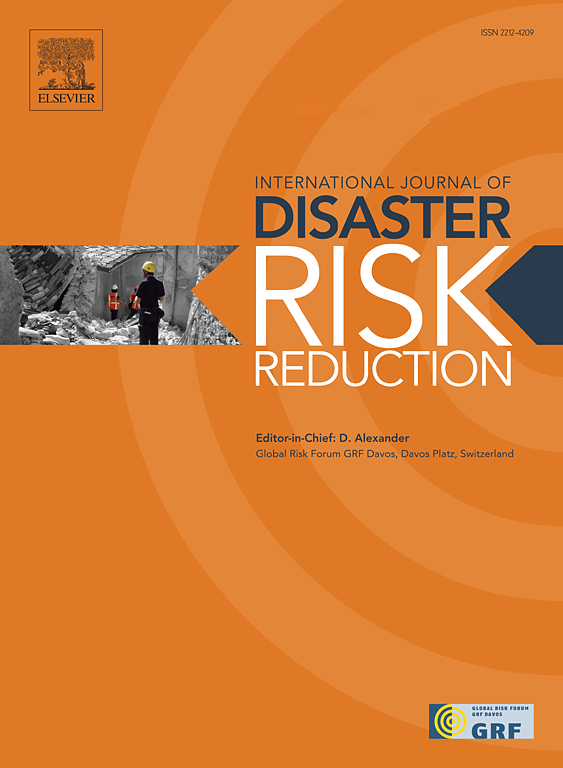社会经济脆弱性和洪水影响的空间计量经济模型:马拉维南部的风险分层方法
IF 4.2
1区 地球科学
Q1 GEOSCIENCES, MULTIDISCIPLINARY
International journal of disaster risk reduction
Pub Date : 2025-04-15
DOI:10.1016/j.ijdrr.2025.105433
引用次数: 0
摘要
随着气候相关灾害的升级,特别是在全球南方的脆弱社区,有效的风险管理战略变得必要。这项工作的目的是研究马拉维南部社会经济脆弱性与洪水影响之间的空间依赖关系,将地理空间方法与计量经济模型相结合。分析显示,统一受益人登记册、马拉维人口普查和2020年和2022年洪水的快速损害评估数据具有显著的空间依赖性和溢出效应。莫兰的分析强调了考虑这些空间溢出效应的必要性。空间计量经济学框架,由空间广义线性模型中的空间滞后变量表示,有效地捕获了这些依赖关系。洪水影响与财富、教育和家庭储蓄等社会经济指标之间出现了预期的关联,这表明经济上有保障的家庭不太容易受到影响。然而,意想不到的相关性也出现了:粮食安全与洪水影响呈正相关,而残疾发生率呈负相关。这些发现挑战了弹性假设,并引起了对数据准确性和余震动力学的关注。见解强调,DRM战略需要纳入风险和社会经济指标,同时改进数据收集,以确保弱势群体得到充分代表。尽管面临数据稀缺性和空间粒度的挑战,但本研究证明了空间计量模型在识别空间互联脆弱性方面的潜力。该方法可以转移到其他情况下,但需要进一步研究以改进空间分辨率并确保可操作的脆弱性特征。将空间依赖关系纳入风险评估凸显了空间明确政策干预的必要性,以加强复原力和推进风险分层战略。本文章由计算机程序翻译,如有差异,请以英文原文为准。
Spatial econometric modeling of socioeconomic vulnerability and flood impact: Towards a risk-layering approach in southern Malawi
As climate-related disasters escalate, particularly in vulnerable communities in the Global South effective risk management strategies become necessary. The objective of this work was to examine the spatial dependencies between socioeconomic vulnerability and flood impacts in Southern Malawi, merging geospatial methods with econometric modeling. The analysis revealed significant spatial dependencies and spillover effects from data in the Unified Beneficiary Register, Malawi Census, and Rapid Damage Assessments from the 2020 and 2022 floods. Moran's I analysis emphasized the need to account for those spatial spillover effects. The spatial econometric framework, represented by a spatial lag variable in the Spatial Generalized Linear Model, captured these dependencies effectively. Expected associations emerged between flood impacts and socioeconomic indicators such as wealth, education, and household savings, suggesting that economically secure households are less vulnerable. However, unexpected correlations also appeared: food security was positively associated with flood impact, while disability occurrence showed a negative association. These findings challenge resilience assumptions and raise concerns about data accuracy and aftershock dynamics. Insights highlight the need for DRM strategies that incorporate exposure and socioeconomic indicators, along with improved data collection to ensure vulnerable groups are adequately represented. Despite challenges from data scarcity and spatial granularity, this study demonstrates the potential of Spatial Econometric Models to identify spatially interconnected vulnerabilities. The approach can be transferred to other contexts, but further research is needed to refine spatial resolutions and ensure actionable vulnerability characterizations. Integrating spatial dependencies into risk assessments highlights the need for spatially explicit policy interventions to strengthen resilience and advance risk-layering strategies.
求助全文
通过发布文献求助,成功后即可免费获取论文全文。
去求助
来源期刊

International journal of disaster risk reduction
GEOSCIENCES, MULTIDISCIPLINARYMETEOROLOGY-METEOROLOGY & ATMOSPHERIC SCIENCES
CiteScore
8.70
自引率
18.00%
发文量
688
审稿时长
79 days
期刊介绍:
The International Journal of Disaster Risk Reduction (IJDRR) is the journal for researchers, policymakers and practitioners across diverse disciplines: earth sciences and their implications; environmental sciences; engineering; urban studies; geography; and the social sciences. IJDRR publishes fundamental and applied research, critical reviews, policy papers and case studies with a particular focus on multi-disciplinary research that aims to reduce the impact of natural, technological, social and intentional disasters. IJDRR stimulates exchange of ideas and knowledge transfer on disaster research, mitigation, adaptation, prevention and risk reduction at all geographical scales: local, national and international.
Key topics:-
-multifaceted disaster and cascading disasters
-the development of disaster risk reduction strategies and techniques
-discussion and development of effective warning and educational systems for risk management at all levels
-disasters associated with climate change
-vulnerability analysis and vulnerability trends
-emerging risks
-resilience against disasters.
The journal particularly encourages papers that approach risk from a multi-disciplinary perspective.
 求助内容:
求助内容: 应助结果提醒方式:
应助结果提醒方式:


